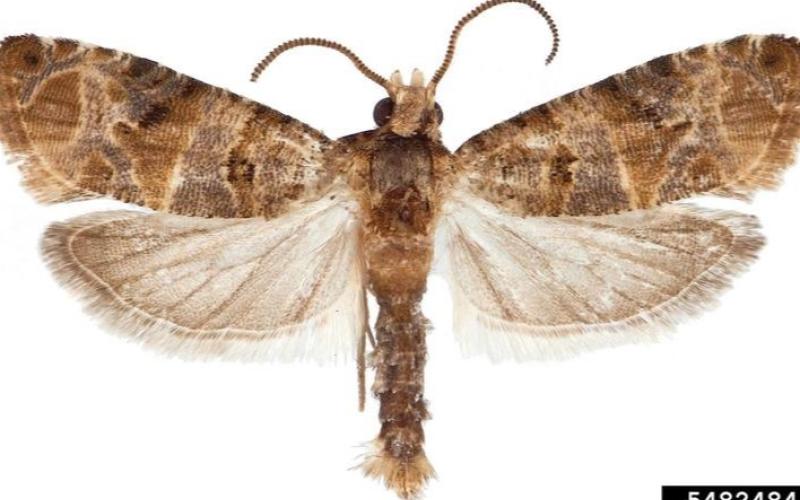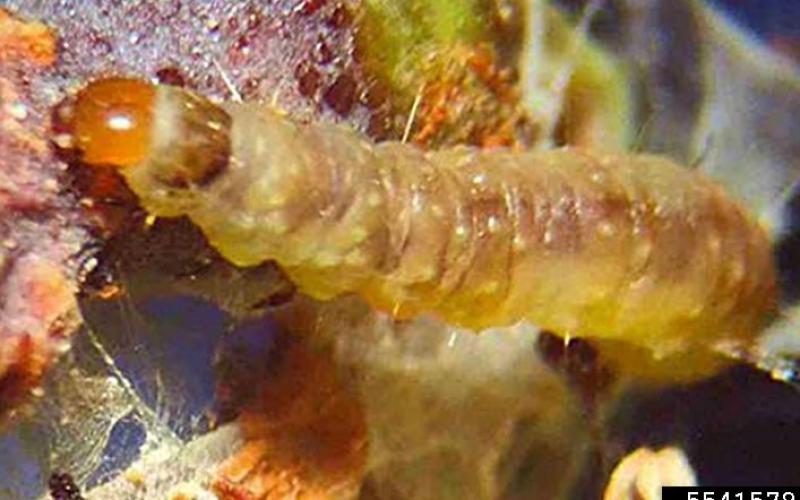Other common names: European grape berry moth, European vine moth, European grape moth
Scientific name: Lobesia botrana (Denis & Schiffermuller)
History
The European grapevine moth (EGVM) is native to Eurasia and Northern Africa, but was detected in Napa County, California in 2009. However, as of August, 2016 it has been declared eradicated from the U.S. by the United States Department of Agriculture.
Biology
Grape (Vitis spp.) is the preferred food of EGVM, however it is known to feed on a wide variety of other cultivated and wild hosts. Adult moths emerge in the spring after accumulation of about 150 Growing Degree Days. After mating, first generation females lay eggs on buds and flowers. Larvae feed on the buds, flowers and developing fruits within webs and eventually pupate in rolled leaves or flower clusters before emerging as adults. Second generation females lay eggs on berries and larvae feed within individual berries. In warm climates a total of three to four generations may occur. In Minnesota it may be unlikely for more than two generations to occur. Decreasing day length triggers pupae to enter an overwintering phase. Overwintering pupae may be found under debris on the ground or under loose bark on the vine. The ability of this insect to tolerate Minnesota’s cold winters is not known at this time.
Identification
The American grapevine moth, Endopiza vitana Clemens, is naturally occurring throughout eastern North America. The feeding habit of E. vitana is virtually identical to that of EGVM and while the damage from grape berry moths as a group is distinctive, feeding damage from EGVM will likely be identical to that of E. vitana (one or more berries shriveled with webbing present and one entrance/exit hole in the berry). Likewise, the larvae as well as the adult moths of both species are small, relatively similar in appearance and only distinguishable by trained specialists. Common understanding suggests that most vineyards have relatively consistent damage from E. vitana from year to year. The best way for Minnesota grape growers to stay alert to the presence of EGVM may be vigilance to uncommon levels of grape berry moth damage (indiscernible between the species). If more severe damage than normal is seen, the presence of EGVM can be investigated by the Minnesota Department of Agriculture (MDA). To keep EVGM out of Minnesota, MDA is increasing awareness about this insect, reviewing detection records from California, and inspecting Minnesota nurseries for this insect and other pest threats.
Selected References
- European Grapevine Moth, Lobesia botrana: A New Pest in California. University of California IPM Online.
- Hoover E, Wold-Burkness S, Hilton J, Mollov D, Burkness E, Galvan T, Hemstad P, Hutchison WD. Grape IPM Guide for Minnesota Producers. University of Minnesota.
- Venette RC, Davis EE, DaCosta M, Heisler H, Larson M. 2003. Mini Risk Assessment Grape berry moth, Lobesia botrana (Denis & Schiffermuller) [Lepidoptera: Tortricidae].
What Can I Do?
Contact the MDA via Report a Pest if you suspect an infestation of European grapevine moth in Minnesota.
Smarty Plants Podcast

Discover Smarty Plants, the Minnesota Department of Agriculture's podcast that digs into the fascinating world of invasive species. Join expert guests as they share insights and solutions to protect our environment and agricultural resources. Visit Smarty Plants and start listening today.





